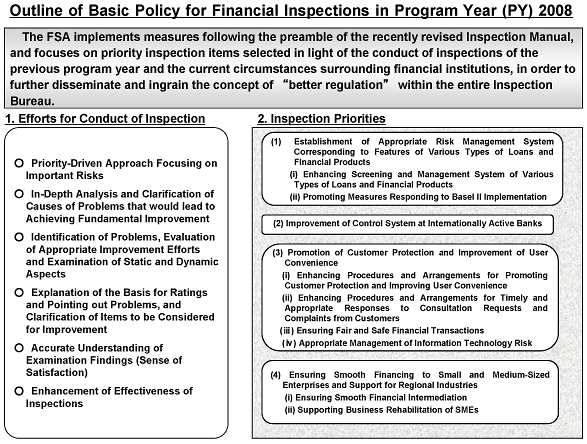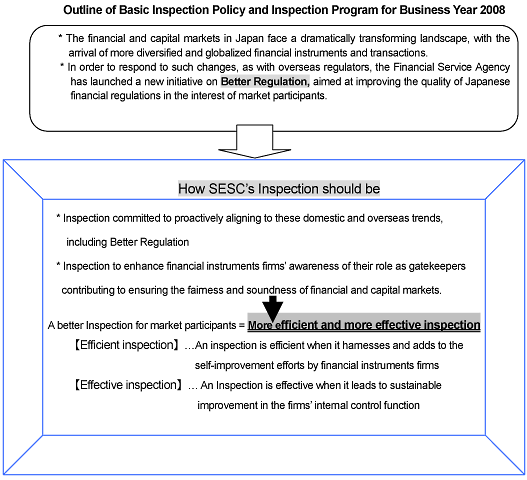 |
 |
Minister Motegi at a press conference after the inaugural cabinet meeting (August 2) |
Minister Motegi taking over from his predecessor, Mr. Watanabe (August 5) |
| [Topics]
[Explanations of Laws and Regulations] |
Statements, Speeches & Material
In this corner, we post statements and speeches made by the Minister, the Senior Vice Minister, the Parliamentary Secretary and FSA officials, as well as presentation material they used.
Speeches
"Japanese Economy: Obstacles and Opportunities" Speech by Toshimitsu Motegi, Minister of State for Financial Services and Administrative Reform, Foreign Correspondents' Club of Japan
Photograph Gallery
In this corner, we post photographs of the Minister, the Senior Vice Minister, the Parliamentary Secretary and FSA officials at work in meetings, conferences and other events.
 |
|
Minister Motegi delivering a speech at the Foreign Correspondents Club of Japan (August 25)
|
 |
|
Minister Motegi at a meeting with the Chinese Ambassador to Japan, Cui Tiankai (August 26)
|
 |
|
Minister Motegi talking with children at the”children visitor’s Day in Kasumigaseki’” event (August 20,21)
|
 |
|
Parliamentary Secretary Uno speaking at a meeting of the panel of experts on the multiple debt problem (September 1)
|
 |
|
A meeting of the panel of experts on the multiple debt problem (September 1)
|
[TOPICS]
1. Introduction
On August 19, the Financial Services Agency (FSA) published the Basic Policy and Plan for Financial Inspections in Program Year 2008, thus revealing its policy for the implementation of inspections and the number of inspections to be implemented in the year. The outline of the plan is described below.
Since last year, the FSA has engaged in efforts to improve the quality of financial regulation, or a “better regulation” initiative. In accordance with the purpose of the better regulation initiative financial inspections by the FSA has taken a priority-driven approach, especially focusing on the responses of financial institutions to the increasing complexity and diversity of risks. Other measures promoted by the FSA include proper operation of the Financial Inspection Rating System that was fully put into force in January this year.
In Program Year 2008, it is the most important task for the FSA to further disseminate and ingrain the concept of “better regulation” throughout the Inspection Bureau and the Ministry of Finance's Local Finance Bureaus. As a basic concept on its conduct of inspections, the FSA intends to implement measures based on the preamble of the recently revised Inspection Manual, and to focus on priority inspection items selected in light of the conduct of inspections in Program Year 2007 and the current circumstances surrounding financial institutions.
2. Basic concept on conduct of inspections
The basic concept on financial inspections to be conducted in Program Year 2008 comprises six items: five points of attention for inspectors, specified in the preambles of the revised Financial Inspection Manual and the Insurance Inspection Manual, both of which were adopted on August 8, 2008; and an “improvement in the effectiveness of inspections,” which refers to the strengthening of cooperation with relevant bureaus and divisions, and training of inspectors.
3. Inspection priorities
Amid the drastic changes in the economic and financial environment both at home and abroad, it is critical for financial institutions to set strategic objectives that clarify their company-wide profit targets and corresponding strategies for both risk-taking and allocating human and physical resources. They must conduct appropriate risk management in line with such strategic objectives.
In this context, the management of financial institutions needs to further enhance their governance system. For its part, when inspecting financial institutions, the FSA will focus on whether they have in place proper legal compliance and risk management systems that conform to their strategic objectives, and whether their governance system for controlling the entire institution is functioning effectively. In particular, in-depth examination will be conducted regarding the following matters. It should be noted that the following items are the inspection priorities as of August 2008, and may be reviewed in light of the situation surrounding financial institutions.
(1) Establishment of appropriate risk management system corresponding to features of various types of loans and financial products
The FSA will examine whether financial institutions precisely identify risks inherent in various types of loans and financial products and whether they conduct appropriate risk management and Asset Liability Management (ALM).
Regarding holding companies, the FSA will examine whether they are conducting comprehensive management of various risks faced by their entire group.
In light of the growing importance of establishing an appropriate risk management system, for example, the FSA will examine screening and risk management systems regarding various types of loans and financial products. In addition, it will examine how financial institutions are responding to the enforcement of Basel II.
(2) Improvement of control system at internationally active banks
In light of the progress made in the expansion of Japanese financial institutions' overseas business operations, the FSA will examine whether they have established appropriate systems for controlling overseas business operations, including anti-money laundering systems as well as systems for information collection and risk identification. At the same time, the FSA will further strengthen cooperation with overseas authorities.
Meanwhile, when inspecting financial conglomerates operating in Japanese markets, the FSA will conduct appropriate examination in cooperation with the Securities and Exchange Surveillance Commission.
(3) Promotion of customer protection and improvement of user convenience
When financial institutions provide a variety of high-quality financial services, they need to engage not only in the basic activities necessary for the protection of customers, such as the management of customer information and prevention of abuse of advantageous positions and conflicts of interest, but also in active efforts to improve convenience for users. From this perspective, the FSA will examine efforts to protect customers in order to check whether minimum standards required for financial institutions, including prevention of inconvenience for customers, have been achieved. In addition, it will examine and evaluate proactive efforts to meet increasing customer needs, and improvements in systems for enhancing convenience for customers in pursuit of best practices.
Specifically, in accordance with the purpose of the Financial Instruments and Exchange Act, the FSA will examine whether financial institutions act flexibly in dealing with customers while sufficiently considering each customer's knowledge, experience and understanding of risk. Regarding insurance companies, the FSA will examine the status of efforts toward improvement to prevent the recurrence of the non-payment of insurance claims. Also, the FSA will examine whether financial institutions (including deposit-taking institutions) are striving to improve their arrangements and procedures for providing services and information that meet the true needs of their customers throughout the life of products, from solicitation to the termination of contracts.
In addition, the FSA will examine the improvement of arrangements and procedures for handling consultation requests and complaints in a timely and appropriate manner, and will also examine efforts toward ensuring fair and secure financial transactions, such as the prevention of transactions with anti-social forces, responses to “furikome” billing fraud cases and the implementation of information security measures. Other matters to be examined and evaluated include efforts toward appropriate management of information technology risk, including responses to system failures and the implementation of measures to enhance management efficiency with the use of IT.
(4) Ensuring smooth financing to small- and medium-sized enterprises and support for regional industries
Ensuring smooth financing to small- and medium-sized enterprises (SMEs), which support Japan's economic foundations, is one of the most important tasks for financial institutions. In particular, regional financial institutions, which serve as financial centers for regional economies, are strongly expected to vigorously exercise their financial intermediary functions in their respective regions, by properly and proactively taking risks under their own responsibilities and judgments and establishing appropriate risk management systems matching such operations.
From this perspective, the FSA will examine, in reference to the supplement to the Financial Inspection Manual, “Treatment of Classifications Regarding Credit to Small- and Medium- Sized Enterprises,” and a report entitled “Urgent Measures for Enhancing Growth Potential,” whether financial institutions have established systems that enable them to exercise their financial intermediary functions smoothly and proactively in ways that reflect the actual state of SMEs. In addition, it will positively evaluate forward-looking initiatives.
Specifically, the FSA will make further efforts to disseminate the supplement to the Financial Inspection Manual, “Treatment of Classifications Regarding Credit to Small- and Medium- Sized Enterprises,” to end-users, including SME managers, through increased public relations efforts, so that SMEs can use it in their efforts for fund-raising. In addition, when examining financial institutions' procedures and arrangements for providing funds to SMEs, the FSA will focus on whether their lending stances are in line with the purpose of the supplement to the Financial Inspection Manual, thereby encouraging them to sufficiently exercise their financial intermediary functions for SMEs.
In order to encourage efforts by regional financial institutions toward the business rehabilitation of SMEs and to promote their use of tools to ensure stable business operations of borrowers, the FSA will examine the actual status of such efforts and positively evaluate superior initiatives and innovative ideas.
4. Outline of the Basic Plan
Under the Basic Plan for Financial Inspections in Program Year 2008, the FSA plans to inspect 285 deposit-taking financial institutions, 20 insurance companies and 285 other financial institutions, including money lenders and prepaid card issuers. Inspections will be conducted in accordance with the purposes of the Basic Policy for Inspections and the Financial Inspection Basic Guidelines (released in July 2005).
5. Conclusion
We believe that financial inspections represent joint work by the FSA and financial institutions toward improvement of the management of the institutions. We will continue to conduct inspections from the viewpoint of the customers of financial institutions and the national economy in accordance with the purpose of the better regulation initiative, in order to ensure the soundness and appropriateness of financial institutions' business operations.
For details, please go to the FSA's web site and access “The Basic Policy and Plan for Financial Inspections in Program Year 2008 (August 19, 2008) at the “Press Releases” section.

On July 25, 2008, the Securities and Exchange Surveillance Commission (SESC) published the Basic Inspection Policy and Inspection Program for Business Year 2008, thus revealing its policy for the implementation of inspections and the number of inspections to be implemented in the year. The outline of the basic policy and plan is described below.
1. Basic inspection policy
(1) Basic concept
The financial and capital markets in Japan face a dramatically transforming landscape, with the arrival of more diversified and globalized financial instruments and transactions. In order to respond to such changes, as with overseas regulators, the FSA has launched a new initiative on better regulation, aimed at improving the quality of Japanese financial regulations in the interest of market participants.
In this situation, the SESC expects that it is important to conduct inspections committed to proactively aligning to these overseas and domestic trends, including better regulation initiative, and to enhance financial instruments firms' awareness of their role as “gatekeepers” contributing to ensuring the fairness and soundness of financial and capital markets. To this end, the SESC plans to conduct more efficient and more effective inspections, which we believe are desirable for market participants. “An efficient inspection” means an inspection that harnesses and adds to the self-improvement efforts by financial instruments firms. “An effective inspection” leads to susutainable improvement in the financial instruments firms' internal control function.
Specifically, the SESC will conduct more efficient and more effective inspections with due consideration of the need to do the following:
1) Adequate combination of principle-based inspections with an eye on the improvement in financial instruments firms' business management systems, and the customary rulebased verification of their compliance to market rules.
2) A sharper risk-focused approach, with a more forward-looking mind-set, in the selection of financial instruments firms to be inspected, as well as areas to be inspected.
3) More emphasis placed on interactive dialogues with financial instruments firms, with a view to encouraging their voluntary efforts toward developing stronger internal control functions.
4) More transparency and predictability in the inspection process, for example through the publication of a revised “The Inspection Manuals for Financial Instruments Firms”.
(2). Areas of inspection focus
In the current policy, the SESC's inspections will focus on the following inspection areas:
1) Verification of market intermediary functions of financial instruments firms Verify the systems to prevent transactions by anti-social forces and to report suspicious transactions Verify the appropriateness of underwriting examination of securities, etc.
Verify the IT system risk management
2) Verification of the management of undisclosed corporate information
(Prevention of unfair insider trading)
3) Verification concerning the appropriateness of asset management businesses. .
4) Verification of conduct that may hinder fair price formation
5) Verification concerning the state of soliciting investors and the appropriateness of segregation
6) Verification for the appropriate exercise of SROs function
7) Verification concerning financial instruments firms to be newly inspected, and new financial instruments.
8) Improvement of problems identified in previous inspections
2. Basic inspection program
Under the Basic Inspection Program for Business Year 2008, inspections will be conducted on 130 Type I financial instruments firms (including 110 companies to be inspected by Local Financial Bureaus), etc., and 70 asset management firms and investment advisories and agencies (including 35 firms to be inspected by Local Finance Bureaus). In addition, Selfregulatory organizations and Type II financial instrument firms will be inspected as necessary.




[Explanations of Laws and Regulations]
FSA Announces Revisions of “Comprehensive Guidelines for the Supervision of Major Banks etc.,” “Comprehensive Guidelines for the Supervision of Small- and Medium-Size and Regional Financial Institutions” and the “Comprehensive Guidelines for the Supervision of Trust Companies, etc.”
On August 6, 2008, the FSA revised the “Comprehensive Guidelines for the Supervision of Major Banks Etc.,” “Comprehensive Guidelines for the Supervision of Small- and Medium- Size and Regional Financial Institutions” and the “Comprehensive Guidelines for the Supervision of Trust Companies, etc.” The outline of the revisions is as follows:
1. Revisions of “Comprehensive Guidelines for the Supervision of Major Banks etc. and “Comprehensive Guidelines for the Supervision of Small- and Medium-Size and Regional Financial Institutions”
As the ongoing subprime mortgage problem has caused financial institutions to incur huge losses, U.S. and European supervisory authorities and international organizations have examined how financial institutions manage their risks and how risks should be managed, and the lessons learned through this process have been made public in a report compiled by the Financial Stability Forum and other reports. Japanese authorities have also conducted similar examination. The FSA has strived to identify the points of attention for risk management through hearings with financial institutions, while the Bank of Japan announced points of attention for the management of risks related to investment in securitized products.
In light of the results of the examination and the lessons learned, the FSA has revised the “Comprehensive Guidelines for the Supervision of Major Banks etc.” and the “Comprehensive Guidelines for the Supervision of Small- and Medium-Size and Regional Financial Institutions.” Additional points of attention adopted as a result of the revisions are as follows:
(1) Risk Management System
* Does the management team proactively and promptly decide the policies for the conduct of business operations and the management of risks from a broad perspective?
* Does the financial institution collect and analyze a broad range of information that may affect the valuation of its own assets, including information concerning economic developments both at home and abroad, and have in place systems that enable the management team to properly and promptly decide policies for the conduct of business operations and the management of risks?
* Has the financial institution established systems that enable quick and appropriate investment decisions from the viewpoint of its overall portfolio, based on the recognition that if individual business divisions make investment without maintaining coordination with each other regarding the type of assets or other features of their assets, the effectiveness of its risk management may be undermined due to the concentration of risks for the institution as a whole?
* Does the financial institution conduct risk management on a group basis, including overseas subsidiaries, affiliates and branch offices?
(2) Elements and method of risk management
* When using VaRs for risk management, does the financial institution strive to select appropriate observation periods, holding periods, confidence intervals, measurement techniques and appropriate input data, and verify the measurement results and ensure valid results?
* Does the financial institution strive to use a variety of risk measurement techniques and improve risk management techniques, including stress testing, based on the recognition that statistical risk measurement techniques have their limitations?
* Does the financial institution strive to improve its stress testing by, for example, conducting analysis based not only on historical scenarios but also on simulated scenarios?
* Does the financial institution have in place systems that enable the Board of Directors, etc., to use the conditions and results of stress testing for making specific decisions regarding risk management?
(3) Risk management regarding credit investment in securitized products
1) Valuation
* Does the financial institution conduct valuation as objectively as possible?
* When using a valuation model, does the financial institution verify its appropriateness?
* When obtaining valuation from a third party, does the financial institution strive to verify its validity by asking for relevant information?
2) Understanding of the nature of products
* Does the financial institution have in place systems that enable it to avoid excessive dependence on external ratings for its investment in and management of securitized products?
* Does the financial institution strive to understand the nature of investment products by, for example, analyzing the product structure?
* Does the financial institution strive to grasp and monitor the abilities and traits of the originators, managers and other parties involved in the securitization process as well as the systems in which they operate?
3) Management of market liquidity risk
* When investing in securitized products or managing them, does the financial institution properly examine their market liquidity?
* Is the financial institution prepared to consider, in a timely manner, how to respond when it recognizes a possible problem with the market liquidity of a securitized product?
4) Risk management regarding the origination of securitized products
* Does the financial institution conduct a prior study on the pipeline risk (the risk that transferring the risks of the underlying assets to investors may become difficult due to changes in the market environment) when originating and selling securitized products?
* Does the financial institution conduct a study on risks that should be taken into consideration when originating and selling securitized products through an unconsolidated special-purpose company (e.g. reputational risk)?
(4) Management of counterparty risk
Does the financial institution conduct appropriate risk management regarding the major counterparties of its derivatives transactions (e.g. management of exposures by counterparty and type of transaction and implementation of appropriate stress testing that takes into consideration the possibility of a decrease in market liquidity)?
(5) Appropriateness and sufficiency of information disclosure
Regarding exposures in fields of strong interest for the market, does the financial institution actively disclose useful information that matches its own risk profile, in accordance with international best practices?
In addition, we revised items regarding the bank agency business and licensing procedures.
2. Revision of the “Comprehensive Guidelines for the Supervision of Trust Companies, etc.”
Three years after the Trust Business Act was fully revised, we revised the guideline from the viewpoint of ensuing efficient and effective supervisory activities. In addition, we made revisions necessary for clarifying the major points of supervisory attention, with regard to the establishment and improvement of systems for preventing the financing of terrorism and money laundering.
This section provides information regarding the hot topics of the moment, selected from questions and answers given at the Minister's press conferences, etc.
If you wish to find out more, we invite you to visit the "Press Conferences" section of the FSA website.
An inaugural address by Toshimitsu Motegi
I am Toshimitsu Motegi. I have been appointed minister for financial services, administrative reform and civil servant system reform.
Yesterday, the Prime Minister told me at his official residence, “I would like you to fulfill your duties as minister for reform.” When he provided me with a written notice of appointment today, he told me again to proudly fulfill my duties as minister for reform.
(Extract from the press conference on August 2, 2008)
Q: What, specifically, are the pending tasks that you, as minister for financial services, must tackle urgently? Also, could you tell me what measures you intend to take and what timetable you have in mind for their implementation?
A: Although the subprime mortgage problem has caused the global financial turmoil, the financial system in Japan is relatively stable compared with those in the United States and Europe, as I said yesterday. However, tensions remain in the global financial market, so the most important thing to do now is to keep a close watch on future developments with a heightened level of vigilance. The surge in the prices of crude oil and raw materials has increased downside risks for the Japanese economy. As small- and medium-size enterprises in particular face a very severe situation, the financial intermediary function of financial institutions is extremely important. Of course, it is necessary for financial institutions to maintain the soundness of their financial condition. At the same time, however, it is important to ensure smooth financing for small- and medium-size enterprises.
Also, the Prime Minister asked me yesterday to make efforts to develop Tokyo into a financial center that can rival London and New York, so that Japan's financial and capital markets can become more competitive internationally. As you know, the Better Market Initiative was adopted in December last year in order to strengthen the international competitiveness of the Japanese markets, and I would like to promote this initiative steadily.
(Extract from the press conference on August 2, 2008)
Q: Former Minister Watanabe established his own advisory group called the Financial Markets Strategy Team and put forward a variety of recommendations. Do you have any plan to establish your own advisory group or something like that?
A: At this time, I do not have clear plans as to what kind of advisory group to set up or what policy lines to pursue. However, when I served as minister in charge of IT around 2003 to 2004, for example, I set up an expert committee to evaluate the achievements made so far under an IT promotion plan (“e-Japan Strategy”) that was launched in 2001. At that time, I also established two advisory groups on international issues, as I recognized the need to promote the internationalization of IT and formulate an Asia strategy in particular. The establishment of such groups was very effective at least in the field of IT, and it will be important to make use of private-sector knowledge and various personal views of experts for the conduct of administration, including the handling of a variety of financial issues.
(Extract from the press conference on August 2, 2008)
Q: I would like to ask you about the tax system related to securities investment. In a speech yesterday, you talked about a preferential treatment for elderly investors and small-lot investors. Why is preferential treatment for elderly people necessary now? According to your explanation, as I understood it, elderly people hold more than 60% of the financial assets held by Japanese individuals, and so, in order to invigorate the market, it is necessary to provide a preferential treatment for elderly investors. However, I think that what the government should do, as a policy measure, is to provide preferential treatment for people who do not have sufficient savings. What is your view on this?
A: As I made yesterday's speech in English, my explanations may have been insufficient in some respects. We are now making final adjustments in preparation for the submission of our requests regarding the tax system related to securities investment at the end of August. Probably, our requests will include several items, such as the enhancement of the defined contribution pension scheme and the 401K plan. One major pillar will be the preferential treatment for elderly people that you mentioned - a reduced tax rate applicable to investments made by elderly people or the introduction of a tax-free bracket - and another pillar will be a special measure intended to foster small-lot investors through a preferential treatment, which may be called the Japanese version of the ISA (Individual Savings Account). I think that it is very important to not only provide preferential treatment for elderly people but also foster a broad base of ordinary investors.
Certainly, elderly people hold about 60% of financial assets owned by Japanese individuals, worth 1,500 trillion yen, or 2.9 times as large as Japan's GDP. In particular, elderly people hold 70% of overall stock investment trusts. From the viewpoint of elderly people, financial investment is becoming increasingly important as a “second pension plan,” as their interest income is declining while the ratio of dividend income to their family income is rising. We are considering tax revision from this viewpoint. Meanwhile, younger generations hold only a small amount of stock investment trusts, as you pointed out, so it is an important task for them to build up their financial assets by continuing small-lot, longterm investments. Tax measures related to securities investment tend to invite accusations of, and fuel concern about, a preferential treatment of the wealthy. In reality, however, 70% of the people investing in stocks, stock investment trusts and other similar financial products have an annual income of less than 5 million yen. Also, households with an annual income of less than 5 million yen have been increasing their investments recently. In this sense, expanding the class of small-lot investors and supporting elderly people, for whom dividend income is becoming increasingly important as a “second pension plan,” will be two major pillars.
(Extract from the press conference on August 26, 2008)
[Information]
The FSA has started an E-mail Information Service. If you register your e-mail address on the Subscribe Page of the FSA website, we will notify you by e-mail once on each day when new information is posted on our website. For details, please access Subscribing to E-mail Information Service of the FSA website.
Site Map
- Press Releases & Public RelationsPage list Open
- Press Releases
- Press Conferences
- Official Statements
- FSA Weekly Review & ACCESS FSA
- Speeches
- For Financial Users
- Others
- Archives
- Laws & RegulationsPage list Open
- Name of Laws and Regulations(PDF)

- Recent Changes (Legislation, Ordinances, Guidelines)
- Guidelines
- Financial Instruments and Exchange Act
- Financial Monitoring Policy
- Public Comment
- No-Action Letter System
- Procedures concerning Foreign Account Management Institutions
 Search
Search



